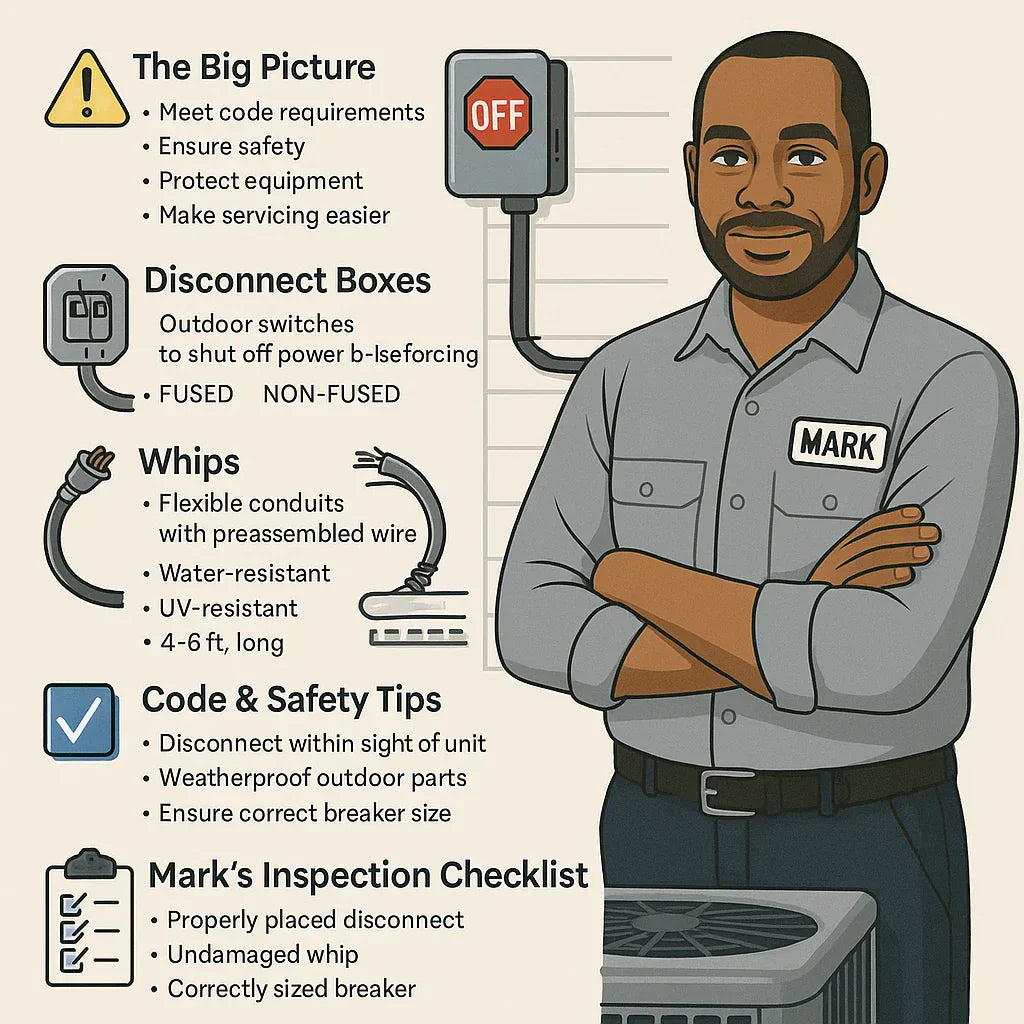By Mark — Your HVAC Safety-First Guy
When it comes to your HVAC system, electrical components aren’t just a technicality—they’re the backbone of safe operation. I’ve seen too many jobs where the cooling system looked fine, but the electrical side was a disaster waiting to happen.
This guide is here to make sure you know what each electrical accessory does, why it matters, and how to choose the right one—without needing a full electrician’s license.
We’ll cover:
-
Disconnect boxes — The emergency off-switch for your outdoor unit
-
Whips — Flexible connections that make installation cleaner and safer
-
Breakers — Your system’s first line of defense against overloads
-
Code rules & safety tips
-
Maintenance & troubleshooting
🧩 1. The Big Picture: Why Electrical Accessories Matter
Your HVAC’s electrical setup needs to:
-
Meet code requirements — Avoid fines and failed inspections.
-
Ensure safety — Quick power shut-off prevents injury during service.
-
Protect equipment — Prevent damage from surges, shorts, or overloads.
-
Make servicing easier — Save time and money on future repairs.
Mark’s Note: In my early career, I saw an outdoor AC unit wired straight to the main panel—no disconnect box, no whip, just hard conduit. The first time it needed service, the tech had to run inside to shut the breaker off. That’s not just inconvenient—it’s dangerous.
🛑 2. Disconnect Boxes
What they do:
A disconnect box is a safety switch located near your outdoor HVAC unit, allowing technicians to cut power before servicing.
Types:
-
Fused disconnect — Contains fuses to protect against overloads
-
Non-fused disconnect — Just a switch; relies on breaker for overload protection
Location requirements:
-
Must be within sight of the unit (usually within 50 feet)
-
Must be weatherproof if outdoors
Materials:
-
Galvanized steel
-
Powder-coated aluminum
-
UV-resistant plastic
Mark’s Tip: In coastal areas, choose a corrosion-resistant box with a NEMA 3R or better rating.
🔌 3. Whips
A whip is a short, flexible conduit assembly that connects the disconnect box to the outdoor unit.
It typically comes preassembled with:
-
Flexible conduit (PVC-coated or liquid-tight)
-
Pre-pulled copper wires (THWN or similar)
-
Fittings on each end
Why they matter:
-
Allow for vibration without stressing wires
-
Easier to install than rigid conduit
-
Protect wiring from weather and pests
Lengths: Commonly 4–6 feet
Wire size: Must match unit’s ampacity per NEC code
🛡 4. Breakers
A breaker is a switch in your electrical panel that trips when current exceeds safe levels.
Your HVAC breaker size depends on:
-
Manufacturer specifications (label on unit)
-
Wire size
-
NEC ampacity charts
Common sizes for residential HVAC:
-
30A
-
40A
-
50A
Mark’s Warning: Oversizing a breaker is a fire hazard. Always match the unit’s nameplate rating.
📜 5. Code Requirements
Key NEC (National Electrical Code) points:
-
Disconnect within sight of unit (Article 440)
-
Weatherproof enclosures outdoors (Article 312)
-
Correct breaker sizing (Article 240)
-
Grounding per manufacturer and code
-
Wire insulation rated for wet locations outdoors
🧰 6. Choosing the Right Gear
Disconnect Box:
-
Match voltage (120V or 240V)
-
Decide fused vs. non-fused based on system needs
-
Check NEMA rating for location
Whip:
-
Length sufficient for flexible routing
-
Wire gauge per NEC
-
Conduit rated for outdoor/wet conditions
Breaker:
-
Match manufacturer nameplate
-
Use compatible brand for your panel
🛠 7. Installation Basics
Disconnect Box:
-
Mount securely to wall near outdoor unit
-
Connect incoming power from panel
-
Connect outgoing whip to unit
-
Ensure box is grounded
Whip:
-
Connect to disconnect box and unit
-
Avoid sharp bends or crushing
-
Secure with fittings
Breaker:
-
Shut off main power
-
Install breaker into panel slot
-
Connect wires per panel manufacturer instructions
🧼 8. Maintenance Tips
-
Quarterly: Check disconnect box for corrosion or loose connections
-
Annually: Test breaker trip function
-
After storms: Inspect whip for damage or water intrusion
🚨 9. Troubleshooting
Symptom: Unit won’t start
-
Check breaker
-
Check disconnect box fuse (if fused type)
-
Check whip for damage
Symptom: Breaker trips often
-
Possible short or overload—call a pro
📌 10. Mark’s Inspection Checklist
-
✅ Disconnect within sight and weatherproof
-
✅ Whip undamaged and flexible
-
✅ Breaker sized to nameplate
-
✅ All grounds secure
-
✅ No corrosion present
🏁 11. Key Takeaways
-
Electrical accessories keep HVAC safe, code-compliant, and serviceable
-
Always size breakers and wires per unit nameplate and NEC code
-
Outdoor components must be weatherproof and corrosion-resistant
-
Regular inspection prevents costly failures
References
In the next topic we will read more about: Insulation Wraps, Tape & Sealants: Improving Efficiency the Easy Way







